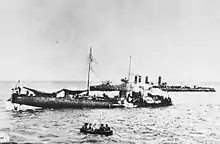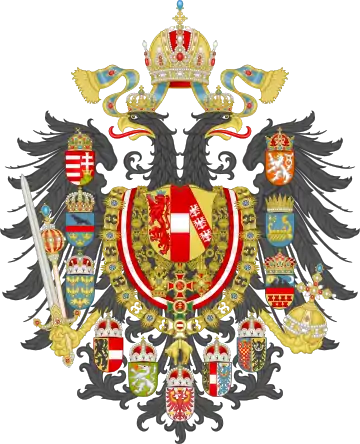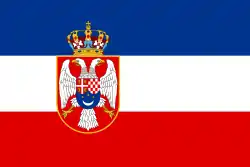Kaiman-class torpedo boat
The Kaiman class were high-seas torpedo boats built for the Austro-Hungarian Navy between 1904 and 1910. A total of 24 boats were built by three shipbuilding companies. Yarrow Shipbuilders built the lead ship, Stabilimento Tecnico Triestino of Trieste built 13 boats, and Ganz-Danubius constructed the remaining 10 boats at their shipyards at Fiume. The class was considered to be a successful design, and all boats saw extensive active service during World War I, undertaking a range of tasks, including escort duties, shore bombardments, and minesweeping. All survived, although several were damaged by naval mines and collisions. One was torpedoed and badly damaged by a French submarine, and two sank an Italian submarine. All the boats were transferred to the Allies and scrapped at the end of the war, except for four that were allocated to the navy of the newly created Kingdom of Serbs, Croats and Slovenes. These were discarded and broken up between 1928 and 1930.
 69 F (later renamed T11) photographed in 1916 | |
| Class overview | |
|---|---|
| Builders: | |
| Operators: | |
| Preceded by: | Cobra class |
| Succeeded by: | 110t class |
| Built: | 1904–1910 |
| In commission: | 1905–1930 |
| Completed: | 24 |
| General characteristics | |
| Type: | Sea-going torpedo boat |
| Displacement: | 209–211 t (206–208 long tons) (full load) |
| Length: | 56 m (183 ft 9 in) |
| Beam: | 5.5 m (18 ft 1 in) |
| Draught: | 1.3 m (4 ft 3 in) |
| Installed power: | |
| Propulsion: |
|
| Speed: | 26 knots (48 km/h; 30 mph) |
| Endurance: |
|
| Complement: | 31 |
| Armament: |
|
Design and construction
After the commissioning of the last of four Cobra class torpedo boats for the Austro-Hungarian Navy in 1900, there was a four-year hiatus in Austro-Hungarian construction of destroyers and torpedo boats. In 1904, a prototype of a new torpedo boat was ordered from Yarrow Shipbuilders at Poplar, London, and this became the lead boat of the Kaiman class. The name was in keeping with other reptilian names given to sea-going vessels. Two Austro-Hungarian naval shipbuilders then received plans and engineering assistance from the British and commenced construction; 13 boats were built by Stabilimento Tecnico Triestino, located at Trieste, and the remaining 10 boats by Ganz-Danubius at their shipyards at Fiume. All boats used a single four-cylinder vertical triple expansion engine driving one propeller shaft using steam generated by two coal-fired Yarrow boilers. They had a waterline length of 56 m (183 ft 9 in), a beam of 5.5 m (18 ft 1 in), and a normal draught of 1.3 m (4 ft 3 in). They had a standard displacement of about 209–211 tonnes (206–208 long tons). The crew consisted of 31 officers and enlisted men.[lower-alpha 1] Their machinery was rated at 3,000 indicated horsepower (2,200 kW) and was designed to propel the boats to a top speed of 26 knots (48 km/h; 30 mph). They carried 47 tonnes (46 long tons) of coal, which gave them a radius of action of 500 nautical miles (930 km; 580 mi) at 26 knots (48 km/h; 30 mph), or 1,030 nmi (1,910 km; 1,190 mi) at 16 knots (30 km/h; 18 mph).[1][2][3]
They were armed with four Škoda 47 mm (1.9 in) L/33[lower-alpha 2] guns and three 450 mm (17.7 in) torpedo tubes.[4] The 47 mm guns were license-built versions of the British QF 3-pounder Hotchkiss gun; they had a rate of fire of 25 rounds per minute and an effective range of 3,000 m (9,800 ft).[5] The 450 mm torpedoes were the L/5 type, which carried a 95 kg (209 lb) warhead and had a range of 3,000 m at a speed of 32 knots (59 km/h; 37 mph). Later variants increased the warhead to 110 kg (240 lb) and the range to 6,000 m (20,000 ft) at 27 knots (50 km/h; 31 mph).[6] In 1915, one 8 mm (0.31 in) machine gun was added.[1] The boats were initially given names, but were redesignated with numbers on 1 January 1914, with three suffixes; E for the Yarrow boat built in England, T for the boats built in Trieste, and F for the boats built in Fiume.[4]
| Initial name | Laid down | Launched | Completed | Redesignated |
|---|---|---|---|---|
Kaiman | October 1904 | 3 June 1905 | 14 September 1905 | 50 E |
Anaconda | 11 October 1905 | 8 May 1906 | 21 September 1906 | 51 T |
Alligator | 20 October 1905 | 30 June 1906 | 31 December 1906 | 52 T |
Krokodil | 14 November 1905 | 25 July 1906 | 31 December 1906 | 53 T |
Wal | 12 December 1905 | 10 September 1906 | 15 June 1907 | 54 T |
Seehund | 29 December 1905 | 15 September 1906 | 15 June 1907 | 55 T |
Delphin | 12 May 1906 | 29 November 1906 | 15 June 1907 | 56 T |
Narwal | 19 June 1906 | 17 December 1906 | 15 June 1908 | 57 T |
Hai | 9 July 1906 | 24 March 1907 | 15 June 1908 | 58 T |
Möve | 1 August 1906 | 30 March 1907 | 15 June 1908 | 59 T |
Schwalbe | 14 September 1906 | 8 April 1907 | 20 March 1909 | 60 T |
Pinguin | 18 September 1906 | 18 April 1907 | 20 March 1909 | 61 T |
Drache | January 1907 | 13 July 1907 | 20 March 1909 | 62 T |
Greif | January 1907 | 8 July 1907 | 20 March 1909 | 63 T |
Triton | 26 July 1907 | 18 July 1908 | 31 December 1908 | 64 F |
Hydra | 31 July 1907 | 11 October 1908 | 19 January 1909 | 65 F |
Skorpion | 14 August 1907 | 15 November 1908 | 22 January 1909 | 66 F |
Phönix | 7 January 1908 | 10 January 1909 | 3 August 1909 | 67 F |
Krake | 2 June 1908 | 7 February 1909 | 15 September 1909 | 68 F |
Polyp | 27 July 1908 | 17 April 1909 | 15 September 1909 | 69 F |
Echse | 22 October 1908 | 8 May 1909 | 15 June 1910 | 70 F |
Molch | 21 November 1908 | 14 July 1909 | 15 June 1910 | 71 F |
Kormoran | 13 January 1909 | 31 July 1909 | 5 March 1910 | 72 F |
Alk | 12 February 1909 | 2 October 1909 | 15 June 1910 | 73 F |
Service history
At the outbreak of World War I, the Kaiman-class torpedo boats were split between the 1st and 2nd Torpedo Craft Flotillas, based at Cattaro and Pola respectively. In the 1st Torpedo Craft Flotilla, the 3rd Torpedo Craft Division had two groups of Kaiman-class boats: 50 E, 51 T and 73 F made up the 2nd Torpedo Boat Group, and 53 T, 54 T and 56 T made up the 3rd Torpedo Boat Group. In the 2nd Torpedo Craft Flotilla, the 5th Torpedo Craft Division had three groups of the class: 55 T, 68 F and 70 F made up the 4th Torpedo Boat Group; 61 T, 65 F and 66 F comprised the 5th Torpedo Boat Group; and 64 F, 69 F and 72 F made up the 6th Torpedo Boat Group. Also in the 2nd Torpedo Craft Flotilla, the 6th Torpedo Craft Division had three more groups of Kaiman-class boats: 52 T, 58 T and 59 T were in the 7th Torpedo Boat Group; 60 T, 62 T and 63 T made up the 8th Torpedo Boat Group; and 57 T, 67 F and 72 F comprised the 9th Torpedo Boat Group.[7]
The Kaiman class was considered to be a very capable design, and all boats saw significant active service during the war. All survived, although several were badly damaged by naval mines and collisions.[1] On 8 August 1914, 72 F accompanied the protected cruisers Zenta and Szigetvár and the Huszár-class destroyer Uskoke during a shore bombardment of Antivari in Montenegro. This was followed, on 2 September, by another shore bombardment of the Montenegrin coast by the Huszár-class destroyers Scharfschütze and Ulan, assisted by 64 F and 66 F. On 16 September, 68 F and 72 F were involved in a raid and landing at San Giovanni di Medua on the Albanian coast. On 14 February 1915, 68 F, the Huszár-class destroyer Csikos and another torpedo boat bombarded Dulcigno and Antivari on the Montenegrin coastline. On 2 March 1915, the Huszár-class destroyers Ulan, Csikos and Streiter, accompanied by 66 F and 67 F, bombarded Antivari and sank the Montenegrin royal yacht Rumija. Three days later, 57 T also bombarded Antivari.[8]

On 24 May 1915, a large Austro-Hungarian force of three dreadnought battleships, six pre-dreadnought battleships, and four destroyers, accompanied by fifteen Kaiman-class boats and four 250t-class torpedo boats, participated in the Bombardment of Ancona, a shore bombardment operation against the northern Adriatic coast of Italy. On the same day, the pre-dreadnought Radetzky, accompanied by 56 T and 73 F, bombarded Potenza Picena, Termoli and Campomarino.[8] On 18 June, the armoured cruiser Sankt Georg conducted a bombardment of a bridge near Rimini, accompanied by 57 T, 58 T, 63 T and 67 F. On the same day, Szigetvár, 64 F and 69 F bombarded Colonnella, sinking one freighter during the shelling, and sinking two motor schooners encountered off Rimini following the bombardment.[9] On 9 September 1915, 51 T was torpedoed and had her bow blown off by the French submarine Papin while she was patrolling off Palagruža. She was towed to port and presumably repaired.[10]
On 9 July 1916, the scout cruiser Novara, 54 T, 73 F and another torpedo boat raided the Otranto Barrage, the Allied naval blockade of the Strait of Otranto, which resulted in the sinking of two drifters, and damage to two more.[11] Ten days later, 65 F and 66 F sank the Italian submarine Balilla off Lissa.[12] On 8 October, 68 F encountered the Italian Rosolino Pilo-class destroyer Pilade Bronzetti off San Giovanni di Medua, but after a brief chase was able to reach the cover of a shore battery.[13] On 16 November 1917, 61 T and 65 F were part of a minesweeping force supporting the bombardment of a 152 mm (6.0 in) Italian shore battery at Cortellazzo near the mouth of the Piave.[14] All boats were due to have their aft torpedo tube replaced by a single Škoda 66 mm (2.6 in) L/30 anti-aircraft gun in late 1918, but it is not clear whether this actually occurred. 52 T ran aground near Split in December 1918. Following World War I, the Kaiman-class boats were allocated to Great Britain, Italy and the new Kingdom of Serbs, Croats and Slovenes (later renamed Yugoslavia). Great Britain and Italy scrapped their boats, but the Yugoslavs retained 54 T, 60 T, 61 T and 69 F as T12, T9, T10 and T11 respectively. All four were discarded and broken up between 1928 and 1930.[4][15]
Notes
Footnotes
- Gardiner 1985, p. 339.
- Greger 1976, pp. 53–55.
- Domville-Fife & Hopkins 1911, p. 60.
- Greger 1976, p. 55.
- Friedman 2011, p. 295.
- Friedman 2011, pp. 350–351.
- Greger 1976, pp. 11–12, 106–108.
- Cernuschi & O'Hara 2015, p. 168.
- Cernuschi & O'Hara 2015, p. 169.
- Halpern 2012, p. 150.
- Cernuschi & O'Hara 2015, p. 170.
- Koburger 2001, p. 62.
- Cernuschi & O'Hara 2015, p. 171.
- Cernuschi & O'Hara 2016, p. 67.
- Chesneau 1980, p. 357.
References
- Cernuschi, Enrico & O'Hara, Vincent P. (2015). "The Naval War in the Adriatic Part I: 1914–1916". In Jordan, John (ed.). Warship 2015. London, England: Bloomsbury. pp. 161–173. ISBN 978-1-84486-295-5.CS1 maint: ref=harv (link)
- Cernuschi, Enrico & O'Hara, Vincent P. (2016). "The Naval War in the Adriatic Part II: 1917–1918". In Jordan, John (ed.). Warship 2016. London, England: Bloomsbury. pp. 62–75. ISBN 978-1-84486-438-6.CS1 maint: ref=harv (link)
- Chesneau, Roger, ed. (1980). Conway's All the World's Fighting Ships, 1922–1946. London, England: Conway Maritime Press. ISBN 978-0-85177-146-5.CS1 maint: ref=harv (link)
- Domville-Fife, Charles William; Hopkins, John Ommaney (1911). Submarines of the World's Navies. London, United Kingdom: Lippincott. OCLC 805947063.CS1 maint: ref=harv (link)
- Friedman, Norman (2011). Naval Weapons of World War One. Annapolis, Maryland: Naval Institute Press. ISBN 978-1-84832-100-7.CS1 maint: ref=harv (link)
- Gardiner, Robert, ed. (1985). Conway's All the World's Fighting Ships, 1906–1921. London, England: Conway Maritime Press. ISBN 978-0-85177-245-5.CS1 maint: ref=harv (link)
- Greger, René (1976). Austro-Hungarian Warships of World War I. London, England: Allan. ISBN 978-0-7110-0623-2.CS1 maint: ref=harv (link)
- Halpern, Paul G. (2012). A Naval History of World War I. Annapolis, Maryland: Naval Institute Press. ISBN 978-0-87021-266-6.CS1 maint: ref=harv (link)
- Koburger, Charles W. (2001). The Central Powers in the Adriatic, 1914–1918: War in a Narrow Sea. Westport, Connecticut: Greenwood Publishing Group. ISBN 978-0-275-97071-0 – via Questia.CS1 maint: ref=harv (link)

